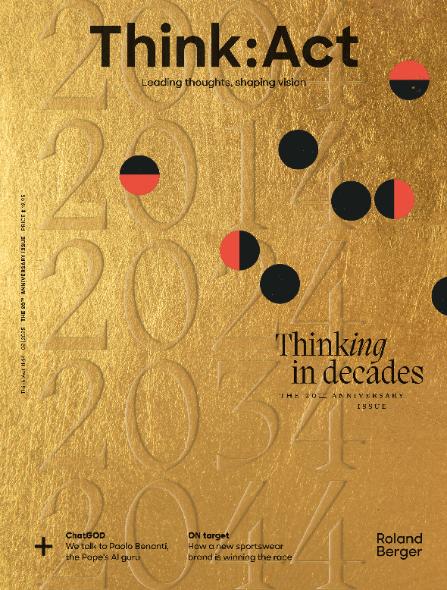Thinking in decades

The latest edition of Think:Act Magazine explores enduring business themes from past decades through a new lens of pertinence for the next 20 years.


Photos Courtesy Webasto Group
Yanni von Roy-Jiang is one of the rare Asian women who has swiftly risen up the ranks in a traditional European family-owned company. For the last 15 years she has worked with the Webasto Group, a more than 120-year-old German-headquartered automotive supplier company, eventually rising to the position of COO and board member. So what does it take to break the proverbial glass ceiling? She laughs off the question, pinning her success on a certain character trait: of being very consistent and persistent, and valuing “eye-level” communication with the rank and file at the company, something that helps her keep her finger on the organization’s pulse.
In this interview with Think:Act, von Roy-Jiang elaborates on the unique advantages of being a cultural hybrid straddling different worlds, and offers a glimpse of the changing world of mobility and how Webasto, despite being more than a century old, is rapidly adapting to the fast-moving industry with the agility of a young company.
Excerpts from an interview:
You are Chinese and you work at a 124-year-old European family-owned company. From this unique vantage point that you have, what are your observations about cultural differences and how they play out at an organizational level?
If we talk about what's the difference between Europeans, especially Germans, and Asians such as the Chinese, I would say Germans like to plan strategically before they do something. They like to think through things, spend a lot of time planning and then maybe they hesitate to execute.
We see in their market evolution that Chinese are unbeatable in their flexibility and speed. If they decide to do something, they do it. They may come back later and say, well, that was not the perfect decision, but nevertheless we learned something.
Born and brought up in China, Yanni von Roy-Jiang worked with Webasto Group in the controlling, purchasing and supply management for a long time before being appointed as Chief Operating Officer and member of the Management Board in 2022.
And how do you bridge these cultural differences?
I came to Germany in 2001 when I was a very young adult and now I'm 44 I still have my Chinese ‘stem’, but I also have the values I got during my ‘growing up’ phase here in Germany since the age of 21. A part of Germany is also inside me. So I benefit from being a ‘cultural hybrid’.
In an international company like Webasto it is really important to understand and respect both cultures. It's not right to say that Germans are so slow. And it is also not right to say that the Chinese do not think things through, they just start projects. It's important that you understand why the people act in this way and you learn to take the good part of both cultures.
The automobile industry is in the throes of transformation. How is Webasto adapting to market shifts, particularly as some of your stronghold businesses – heating systems, for instance – are in the more traditional automobile segments and new segments like EVs are becoming increasingly popular.
We decided to enter the e-mobility market already in 2015. In addition to our core business, we launched three e-mobility-focused business units: battery, the charging business unit and electric heating with the high voltage heater (HVH) business. We were able to foresee that the demand for the fuel-operated heater category would decline so we wanted to offer an e-mobility solution, which is the HVH. So this goes hand in hand: one technology goes down, another goes up.
Talking of the charging business, in 2023 we launched our RE:focus strategy where ‘R’ stands for ‘roof’ and the ‘E’ stands for ‘electrification’. As part of the sharpening of our corporate strategy, we decided to search for a partner and become a minority shareholder of the charging business. We are now focusing on roof systems, batteries and electric heating including thermo management. That is also how we adapt to markets.
"In an international company like Webasto it is really important to understand and respect both cultures ... It's important that you understand why people act in this way and you learn to take the good part of both cultures."
An organization with a long history is almost like a big ship. How do you reorient a big ship for a future business?
At Webasto, transformation is part of our DNA. In the early years, our company manufactured stamped parts, wire hangers and household appliances. One of the first products of Webasto was a mousetrap 120 something years ago! Later with rims, mudguards and chain guards we had been a supplier to the bicycles industry and then with the development of the first folding car roof and a fresh air heater, Webasto became an automotive supplier. So change is part of our DNA and culture. Nevertheless, it's not easy for an organization and especially for the people. The past 10-20 years were the golden years of the automotive industry: all about investment and growth. We have to adapt to the changing market conditions and as part of our strategy, we have defined five key success factors. The most important one is to focus on innovation and customer proximity.
Let me give you an example: We have been the market leader in roof systems for 50-70 years. We need to become even more innovative and provide more customer proximity, especially in view of the market developments in China with growing local competition. We need to not just develop products in Germany and bring them to China, but also empower our Chinese organization to design locally to be able to deliver the products exactly demanded by the Chinese end consumers.
We can leverage digitalization, such as AI, much more to increase plant productivity. We are using big data analytics to reduce our scrap cost. We could use the data to improve preventive maintenance. Our productivity has to become more competitive.
To make these changes we need motivated people who understand the current strategy, the current success factors and the context for certain decisions we have made or we are going to make to keep our strong position in this market.
What is the biggest challenge in making these big shifts happen: people, culture or R&D?
For us at Webasto people centricity is another important success factor, because change is primarily about competency management. Let's say, we want to leverage our productivity through digital solutions. In our plants, where we manufacture roofs, batteries and high-voltage heaters, we have quality technicians. But to leverage productivity through digital solutions, we need a different profile on the shopfloor. We need more IT people who are data experts. They can read the data in relation to machine factors like oil pressure and tooling temperature, and they can map out a pattern and we can adjust the machine and setting factor to leverage the next level of productivity. So competence management is key.
"We can implement a lot of AI solutions without huge cost especially on the shopfloor because the data is there. You just need to put a structure and a person who can do big data analytics very well. This is not that costly, but the output is very big."
What role do you see AI and other technologies playing as Webasto adapts to changes in the automotive industry?
AI is faster data processing: how you leverage the productivity out of the data? On the shopfloor, we used big data analysis to reduce our scrap cost. We have a polyurethan press and you already have a lot of data about the temperature of the upper tool, oil pressure, maintenance statistics about different tool parts and also out of traceability, you can tell that this part would have been produced by this tool by this press just now, and if it's good or not good.
If you get the data in this way, you can map a picture out of the big data: if my upper tool temperature is lower than 92° Celsius for example, I will have more hits on my final product. Then you can set up your machine to produce if the temperature is between 92.5° to 94.5° because in this range the possibility that I have a good part is extremely high.
Five years ago, all this came from the experience of the manufacturing engineer: But now young IT people on the shopfloor can do this supported by cameras and sensors for quality inspection
How do you weigh the tradeoff between the costs you'll incur in perfecting the digital tools and the savings you will eventually achieve?
We can implement a lot of AI solutions without huge cost especially on the shopfloor because the data is there. You just need to put a structure and a person who can do big data analytics very well. This is not that costly, but the output is very big.
With sales of more than 4 billion euros, Webasto today is one of the top 100 automotive suppliers worldwide. Formed in 1901, it is headquartered in Stockdorf, Germany, and has operations in Europe, the Americas and Asia.
How do you leverage various best practices from different parts of the global operations across the organization?
If you take operations, our Chinese colleagues have a lot of very cost-efficient automation ideas. They could leverage this with small investments and get big productivity gains. We bring these ideas to Europe and the Americas region and we create healthy competition between our plants. Our plants in Europe, the US and Mexico feel proud if they can do something better than the Chinese colleagues. The Chinese colleagues also keep on continuously improving because they know that the European and the Americas’ plants are catching up.
Nobody is hiding their good idea. We have what we call ‘Takumi sharing’ for continuous improvement. In this every plant puts their best practice into the system and we honor the teams with awards. For example, who made the most best practice sharing suggestions, which have also been implemented by other plants and which production team used the most best practice ideas from other plants.
How do you see the automotive supplier industry evolving in the next 5-10 years, and what implications does that have for Webasto?
The times of constant growth in our industry are over and the competition is becoming stronger and stronger. The key is to stay very innovative and leverage productivity with digital solutions. Digital solutions are not something you should start to do if you get money. Yes, you need to invest and a lot of smaller suppliers think about huge amounts. But actually, there's a lot of low-hanging fruit you can already get with a small group of people. We can leverage such productivity for our day-to-day business on the shopfloor and through operational excellence, we can save more costs and through these savings, we have the opportunity to invest in innovation.

The latest edition of Think:Act Magazine explores enduring business themes from past decades through a new lens of pertinence for the next 20 years.

